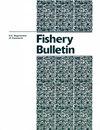Comparison of a bottom longline survey and a bottom trawl survey for 2 groundfish species in the Gulf of Maine to evaluate habitat-related availability of large fish
IF 0.8
4区 农林科学
Q3 FISHERIES
引用次数: 0
Abstract
Massachusetts 02543 Abstract — Understanding fishery-independent survey selectivity is funda- mental to relating relative abundance indices to total population size. The selectivity of a survey in an assessment model represents a combination of gear selectivity and availability of fish to the gear. Concerns have been raised about possible bias in sampling of the bottom trawl survey (BTS) of the NOAA Northeast Fisheries Science Center (NEFSC) caused by the chal-lenges associated with towing in rough- bottom habitat. These difficulties may affect the availability of some fish, such as large ( ≥ 100 cm in total length [TL]) Atlantic cod ( Gadus morhua ). To evaluate the potential presence of BTS habitat- related bias, we compared catches of Atlantic cod and white hake ( Urophycis tenuis ) from BTS sampling in the Gulf of Maine with catches from the NEFSC bottom longline survey, which focuses on rough- bottom habitats in the same region. Differences between survey catches were apparent for large white hake ( ≥ 90 cm TL), supporting the premise of availability differences between surveys for white hake and the assumption of dome- shaped selectivity for the BTS. In contrast, results for Atlantic cod did not support the hypothesis of对缅因湾2种底栖鱼类进行延绳钓调查和拖网调查的比较,以评估与栖息地有关的大型鱼类的可用性
马萨诸塞州02543摘要——了解渔业独立调查的选择性是将相对丰度指数与总种群规模联系起来的基础。评估模型中调查的选择性代表了渔具选择性和渔具中鱼类的可用性的组合。人们对美国国家海洋和大气管理局东北渔业科学中心(NEFSC)底拖网调查(BTS)的采样可能存在偏差表示担忧,这是由于在粗糙的海底栖息地进行拖航造成的挑战。这些困难可能会影响一些鱼类的可用性,例如大型(总长≥100厘米[TL])大西洋鳕鱼(Gadus morhua)。为了评估BTS栖息地相关偏见的潜在存在,我们将缅因湾BTS采样的大西洋鳕鱼和白鳕鱼(Urophycis tenuis)的捕获量与NEFSC底部延绳钓调查的捕获量进行了比较,该调查侧重于同一地区的粗底栖息地。大型白鳕鱼(TL≥90 cm)的调查捕获量之间的差异是明显的,这支持了白鳕鱼调查之间可用性差异的前提,以及BTS圆顶形选择性的假设。相反,大西洋鳕鱼的研究结果并不支持
本文章由计算机程序翻译,如有差异,请以英文原文为准。
求助全文
约1分钟内获得全文
求助全文
来源期刊

Fishery Bulletin
农林科学-渔业
CiteScore
1.70
自引率
12.50%
发文量
76
审稿时长
>24 weeks
期刊介绍:
The quarterly Fishery Bulletin is one of the oldest and most respected fisheries journals in the world. It has been an official publication of the U.S. Government since 1881, under various titles, and is the U.S. counterpart to other highly regarded governmental fisheries science publications. It publishes original research and interpretative articles in all scientific fields that bear on marine fisheries and marine mammal science.
 求助内容:
求助内容: 应助结果提醒方式:
应助结果提醒方式:


